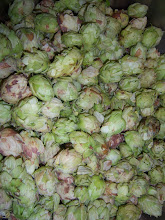 This is our first beer from Pike Brewing Company, located in the Pike Place Market in downtown Seattle, WA, where it has been operating since 1989. You, know, the place with the flying fish from that Levi’s ad from back in the day. Some of all y’all must know what I'm talking about, because everytime I go home there’s a swarm of people snapping photos and standing around gawking. So be wary of the flying fish, and give the pig some love...
This is our first beer from Pike Brewing Company, located in the Pike Place Market in downtown Seattle, WA, where it has been operating since 1989. You, know, the place with the flying fish from that Levi’s ad from back in the day. Some of all y’all must know what I'm talking about, because everytime I go home there’s a swarm of people snapping photos and standing around gawking. So be wary of the flying fish, and give the pig some love...XXXXX Extra Stout has a malty nose with hints of chocolate and molasses; there’s not much in the way of roastiness, at least in the nose. It pours a deep brown with garnet highlights, and has a brown head that leaves behind very little lacing on the glass. Extra Stout begins with a sweet chocolate front before moving into a roasted middle with some bitterness and a touch of burnt malt flavor. It finishes dry with a return of some of the sweetness as well as drawn out bitterness and some lingering burnt flavors. There are also some chalky and/or alkaline flavors in the ending of the beer, although nothing distracting. Extra Stout has a medium to light body with lower carbonation that contributes to building the creamy mouthfeel. In addition to the creaminess, it has a smooth and rounded body; while there is some slight puckering on the
 tongue (it does have 65 IBUs), it works nicely with the overall mouthfeel. There might be some slight warmth buried in the beer, but it doesn’t appear to be alcohol-derived. A very even beer; there is no real harshness or cindery mouthfeel components from the unmalted roast barley—it only comes in as part of the flavor profile, and very evenly when it does. The heavier hop bitterness does cover over some of the sweetness, and gives XXXXX Extra Stout the distinction of being an Extra Foreign stout with a Northwest hop profile, which we think works quite well.
tongue (it does have 65 IBUs), it works nicely with the overall mouthfeel. There might be some slight warmth buried in the beer, but it doesn’t appear to be alcohol-derived. A very even beer; there is no real harshness or cindery mouthfeel components from the unmalted roast barley—it only comes in as part of the flavor profile, and very evenly when it does. The heavier hop bitterness does cover over some of the sweetness, and gives XXXXX Extra Stout the distinction of being an Extra Foreign stout with a Northwest hop profile, which we think works quite well.From the Pike website: “Full-bodied velvety malt texture; hints of chocolate, licorice & espre
 sso. Appropriate anywhere a red wine would be served, yet goes beautifully with delicate dishes like oysters. Originally known as ‘porter’ because the train porters sold it. Some ‘porters’ were called ‘stout’ or ‘extra stout porters.’ In the 19th century, the biggest breweries dropped the word porter. London was the most famous stout capital in the 18th century. In the 19th century, Dublin became famous for a light dry style that advertised its restorative and nutritional benefits. The craft beer movement re-introduced oatmeal, imperial and cream stouts in the early 1980s.”
sso. Appropriate anywhere a red wine would be served, yet goes beautifully with delicate dishes like oysters. Originally known as ‘porter’ because the train porters sold it. Some ‘porters’ were called ‘stout’ or ‘extra stout porters.’ In the 19th century, the biggest breweries dropped the word porter. London was the most famous stout capital in the 18th century. In the 19th century, Dublin became famous for a light dry style that advertised its restorative and nutritional benefits. The craft beer movement re-introduced oatmeal, imperial and cream stouts in the early 1980s.”ABV: 6.6%
IBU: 65
OG: 1.073
Malt: Pale, Crystal, & Roasted
Hops: Chinook, Willamette, & Goldings
(12/11/2009)

No comments:
Post a Comment